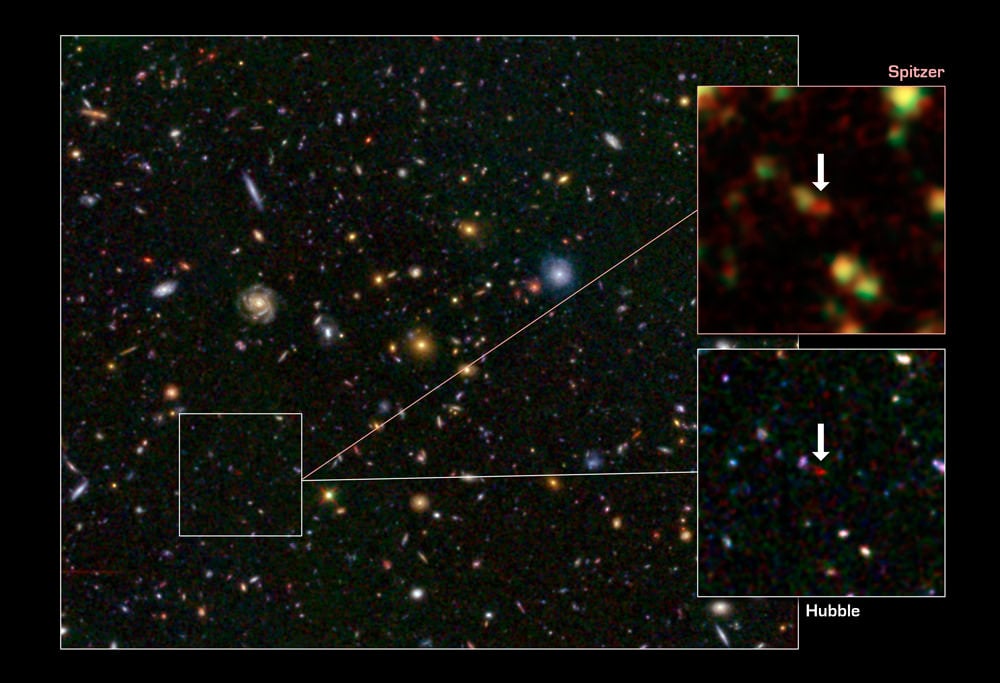[/caption]
Looking back in time with some of our best telescopes, astronomers have found one of the most distant and oldest galaxies. The big surprise about this blob-shaped galaxy, named GN-108036, is how exceptionally bright it is, even though its light has taken 12.9 billion years to reach us. This means that back in its heyday – which astronomers estimate at about 750 million years after the Big Bang -- it was generating an exceptionally large amount of stars in the "cosmic dawn," the early days of the Universe.
"The high rate of star formation found for GN-108036 implies that it was rapidly building up its mass some 750 million years after the Big Bang, when the Universe was only about five percent of its present age," said Bahram Mobasher, from the University of California, Riverside. "This was therefore a likely ancestor of massive and evolved galaxies seen today."
An international team of astronomers, led by Masami Ouchi of the University of Tokyo, Japan, first identified the remote galaxy after scanning a large patch of sky with the Subaru Telescope atop Mauna Kea in Hawaii. Its great distance was then confirmed with the W.M. Keck Observatory, also on Mauna Kea. Then, infrared observations from the Spitzer and Hubble space telescopes were crucial for measuring the galaxy's star-formation activity.
"We checked our results on three different occasions over two years, and each time confirmed the previous measurement," said Yoshiaki Ono, also from the of the University of Tokyo.
Astronomers were surprised to see such a large burst of star formation because the galaxy is so small and from such an early cosmic era. Back when galaxies were first forming, in the first few hundreds of millions of years after the Big Bang, they were much smaller than they are today, having yet to bulk up in mass.
The team says the galaxy's star production rate is equivalent to about 100 suns per year. For reference, our Milky Way galaxy is about five times larger and 100 times more massive than GN-108036, but makes roughly 30 times fewer stars per year.
Astronomers refer to the object's distance by a number called its "redshift," which relates to how much its light has stretched to longer, redder wavelengths due to the expansion of the universe. Objects with larger redshifts are farther away and are seen further back in time. GN-108036 has a redshift of 7.2. Only a handful of galaxies have confirmed redshifts greater than 7, and only two of these have been reported to be more distant than GN-108036.
About 380,000 years after the Big Bang, a decrease in the temperature of the Universe caused hydrogen atoms to permeate the cosmos and form a thick fog that was opaque to ultraviolet light, creating what astronomers call the cosmic dark ages.
"It ended when gas clouds of neutral hydrogen collapsed to generate stars, forming the first galaxies, which probably radiated high-energy photons and reionized the Universe," Mobasher said. "Vigorous galaxies like GN-108036 may well have contributed to the reionization process, which is responsible for the transparency of the Universe today."
"The discovery is surprising because previous surveys had not found galaxies this bright so early in the history of the universe," said Mark Dickinson of the National Optical Astronomy Observatory in Tucson, Ariz. "Perhaps those surveys were just too small to find galaxies like GN-108036. It may be a special, rare object that we just happened to catch during an extreme burst of star formation."
Sources:
Science Paper by: Y. Ono et al.
,
Subaru
,
Spitzer
Hubble
 Universe Today
Universe Today
